The German Tiger tank currently on display in Saumur is one of only six tanks of this type that survive to this day. Out of the six, the history of this one is the most interesting. This tank fought with two armies on both sides of the front, and had its own personal names.
In German hands
The Saumur Tiger left the Henschel factory in the middle of May of 1944. Its chassis is number 251114, the 1114th Tiger to be built, and its turret serial number is 250857. This is a tank from the late production series, the main feature of which was steel road wheels.
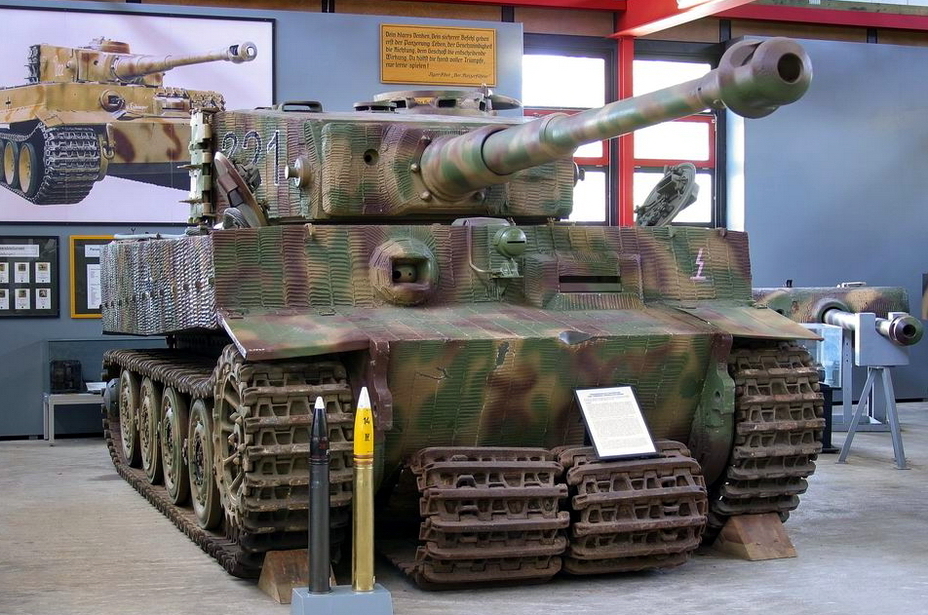
In late May, the shiny new Tiger was included into the newly forming 102th SS heavy tank regiment. The vehicle was sent to the 1st company, 1st battalion, and received the tactical number 114, according to the last digit of its serial number. SS Oberscharführer Wilhelm Schmidt became its first commander.
The battalion fought actively against the Western Allied forces in Normandy starting in July of 1944. The specifics of the Saumur Tiger's career are not known, except for the last 24 hours of its time in the battalion. From the words of a direct participant in these events, the commander of the 1st company, SS Obersturmführer Alois Kalls:
«Our tanks were fighting in the middle of Falais, next to the cathedral, and only retreated to our lines outside the city under orders, after nightfall. The cornerstone of the German defense was broken, and the front began to crumble.
Early on August 18th, we received verbal orders, and began an overall retreat from Willi to Vignats, south of Fresné-la-Mère. We arrived at our destination at 3:00 am and took up a section of the front to the north of the city, right next to the SPGs on our left flank. During the day, British tanks and infantry occupied La Hoguette. After reporting this to the combat group HQ, we received new orders, left our positions immediately, and approached the railroad embankment near Nécy. Tank #124 from the 1st company was knocked out, and we towed it to the outskirts of L'Abbaye. We covered the north-western exit from the city with two SPGs, which forced the British tanks to retreat at around 17:00.
With darkness, we received new orders to immediately retreat and arrive to the checkpoint 500 meters east of Vignats. The knocked out tank was destroyed with an explosive charge and two armour piercing rounds, and blew up. Having arrived at the checkpoint at 00:30, we received new orders. We were to break through Vignats to Nécy with an extra supply of fuel on our engine decks, fuel up tanks from the 1st company, and retreat with them to a hill near Nécy.
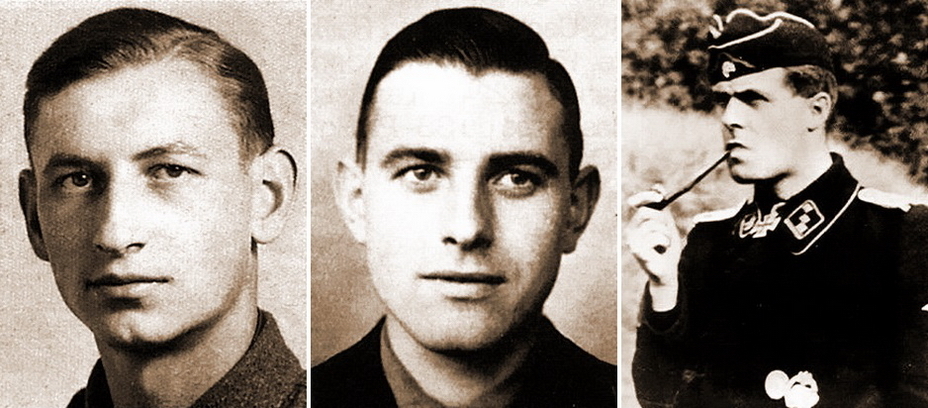
At 2:30, we set out on a dangerous nighttime journey through enemy territory with two 200 Litre barrels of gasoline strapped on behind the turret. A single tracer bullet was enough to fail the mission and destroy the tank and its crew. We set out at full speed, and reached our comrades in an hour without a scratch.
After fuelling up, our little tank group began to retreat to the north-west, as ordered. At 05:15, with first light, we encountered a British anti-tank position at the road. While both sides tried to deal with the surprise, our tank passed the guns and continued along the road at full speed. Schroif, who followed us, opened fire on positions that we didn't notice, and who started firing on us with tracer bullets, but then received two direct hits.
The radio operator and driver were heavily wounded. The third tank (#114, commanded by Unterscharfuhrer Arthur Glagow -author's note) who was following Schroif too closely rammed into his rear at high speed and could not disengage. This happened in seconds. Schroif, wounded in the head and leg, leapt out of his tank and made his way to the cover of the bocage, and further across the field, to German positions. Two crewmen were taken prisoner by the British, except the loader, who managed to do the same thing as Schroif.
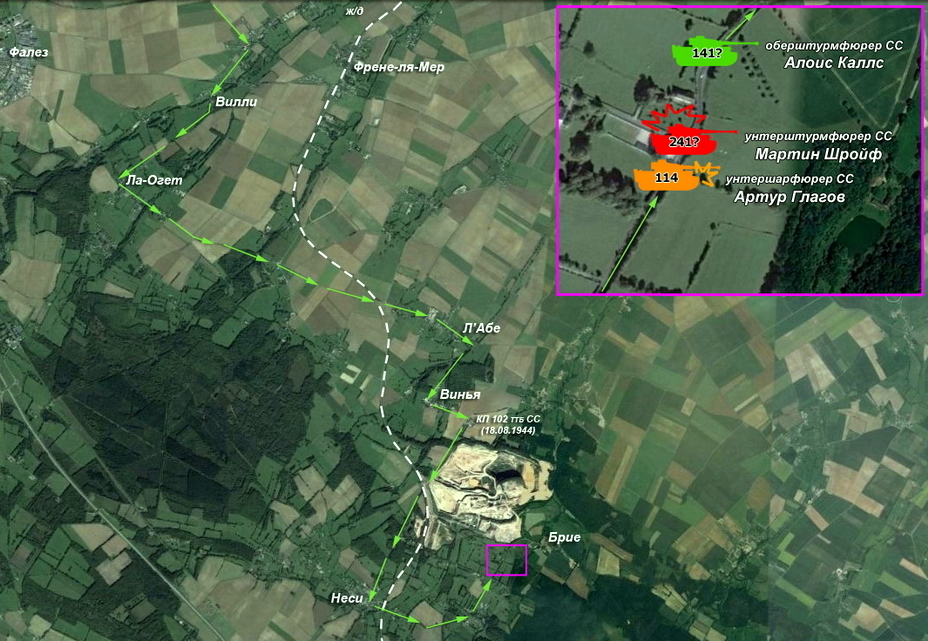
A few minutes later, when other tanks did not catch up, we stopped and decided to return, to see what was holding them up. As soon as we turned the corner, we saw such fireworks, that to continue would be madness. On armour piercing shell from an anti-tank gun hit the turret, another hit the hull, bursts of machinegun fire whipped the armour. Something could happen at any moment. A clear and precise order was given by the commander: «Tank, stop! Tank, forward! March!» The tank stopped so suddenly, that we were slammed against the side, then tore forward, engine roaring. The driver's lightning fast reflexes that drove our 60-ton monster saved our life more than once!»
These events unfolded at a place called Le Fourneau, 500 meters west of of Breux. The British describe them in the combat journal of the 2nd battalion of the Monmouthshire Regiment as follows:
«At about 06:00, we heard the roar of tank engines from the north. Some of us decided that these were Shermans, but the roar was lacking a ringing that was characteristic of Shermans. Several minutes later, we saw three German Tigers. We opened fire from everything we had, but they passed unharmed through D company and reached the intersection, which was defended by C company and the battalion HQ.
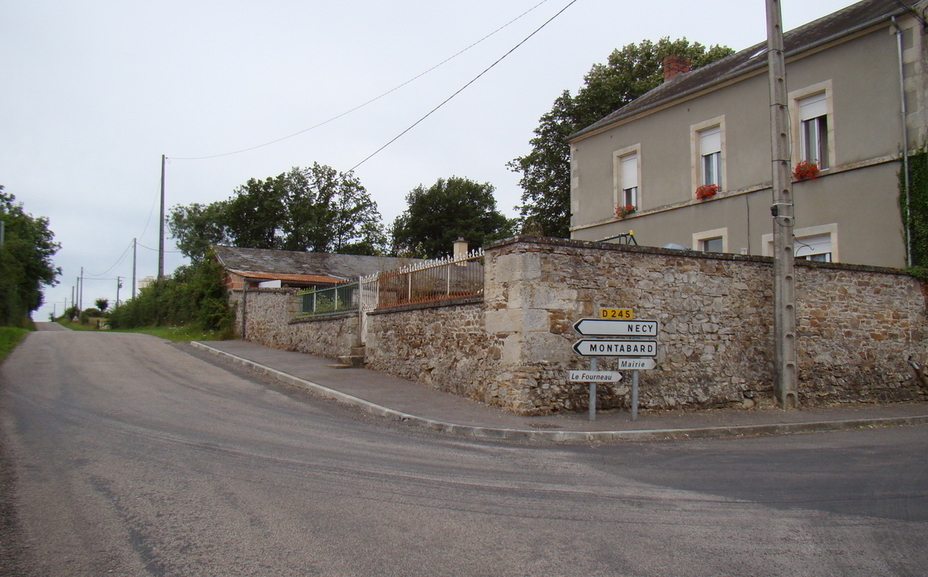
The road was blocked by an artillery observer's armoured carrier. The Tiger rammed it and flung it against the wall of a shed, until there was enough room to get by. Then the Tiger attacked the commander's carrier, which was left by its crew in a hurry. When the road was open, the Tiger continued on through B company's ranks. A clever radio operator warned the company, and we soon heard three loud bangs. The battalion HQ decided that the Tigers opened fire with their 88 mm guns, but, several minutes later, the commander of B company got on the air and informed us that, sadly, one tank got away.
He was being coy. The first Tiger managed to bypass a Hawkins grenade trap near the HQ, but the second activated two of them and drove off into the ditch. The third Tiger, driving at top speed like the rest of the tanks in the group, rammed into the tank that was immobilized in front of him, which, by that point, also took a hit from a PIAT. Its gun barrel penetrated the stowage container on the turret of the second Tiger. Even through the grenade did not penetrate the armour, the crews of both tanks abandoned them in a hurry. The survivors were captured."
Bretagne aka Colmar
The French Interior Forces (Forces Françaises de l'Intérieur – FFI) began forming when the liberation of France started. In early March of 1945, the Besnier Independent Squadron (L'escadron autonome Besnier) joined them. The squadron was commanded by Captain Guy Besnier, who finished the Versailles tank school in 1939.
The squadron was armed with German vehicles, abandoned during the fighting in France. From January to March of 1945, vehicles that could be repaired and put back into order were searched for in all of France. This was not a simple task, as most of the vehicles were disassembled, and remains of the crews had to be extracted from many.
Scroif and Glagow's Tigers were not left without attention. They became known in early January of 1945. A father-son mechanic duo, Roger and Jean Lecourtier, as well as Bernard Verier, put the tank into working order after a month of work. French tricolour insignia was added to the sides, and the tank received a traditional «geographic» nickname: Bretagne.
Aside from the Tiger, the squadron included two Panthers, 11 PzIVs, one Marder, two StuG III, one Jagdpanzer IV, and various transports. Like the Tiger, these vehicles bore French insignia and received French names. One of the Panthers was called Dauphine, some of the PzIVs were called Île-de-France, Poitou, Normandie, Flandre, Vendée, Anjou, Alsace, and the Marder was called Lorraine.
Until the last day of the war, Bretagne the Tiger fought in the FFI to liquidate the encircled forces south of Saint-Nazaire.
On June 20th, 1945, the Besnier Squadron was included into the 6th Cuirassier Regiment as its 2nd squadron. The regiment was sent to Germany, as a part of the French occupation force. Instead of tricolour roundels, the tanks received French flags. Bretagne was repainted, and renamed to Colmar. Initially, the squadron was quartered in Baumholder, but it was moved to Morbach in late October of 1945, which is 50 km to the east of Trier.
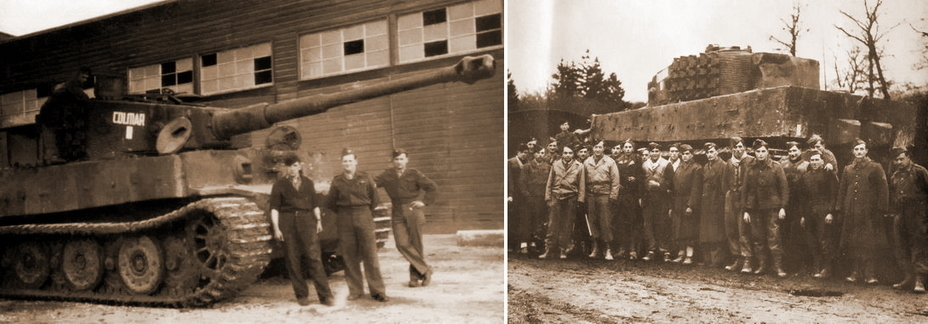
In March of 1946, the 6th Cuirassier Regiment was disbanded, and the tanks and other vehicles were sent to the reserve armoured vehicle service (ERGM/EB, modern day ETAMAT) in Nevoy, near Gien.
Later, in 1950, the tanks and other vehicles were sent to a storage facility belonging to the Satory AMX company, where the Tiger spent 30 years. In 1977, it was passed on to the newly formed tank museum in Saumur. In 2002, the Tiger was temporarily moved to the tank exhibit in Munster, after which it returned to France, where it is on display to this day.
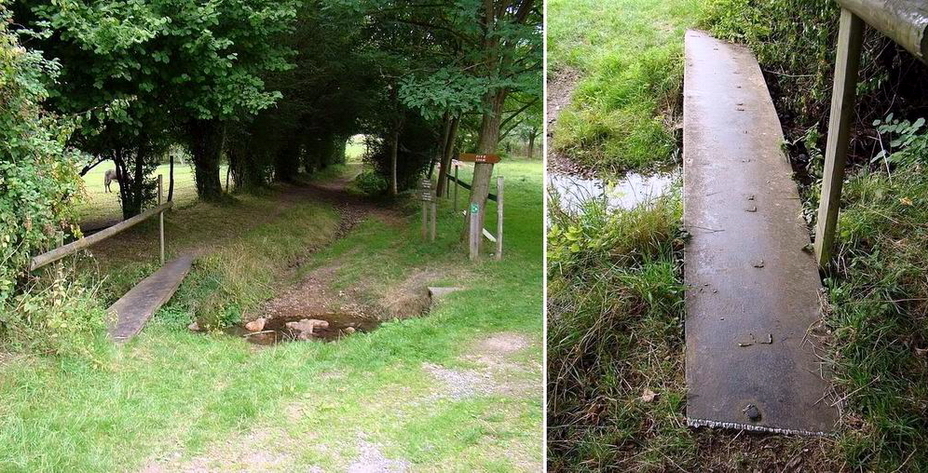
3 km east of the location of the incident with the Tigers of the 102nd SS heavy tank battalion, there is a small stream. A bridge across the stream can be recognized as the side plate of a Tiger tank. Perhaps this is a pat of Schroif's tank, which was not as lucky as its colleague.
Translated by Peter Samsonov. Read more interesting tank articles on his blog Tank Archives.
Sources:
- Luc Braeuer. Les chars de la Resistance: L'etonnate aventure d'un escadron FFI blinde sur poche de Saint-Nazaire – Braeuer, 2007
- Stephan Cazenave, Rudiger Warnick. Tiger! De la schwere Kompanie/SS-Pz.Rgt.2 a la s.SS-Panzerabteilung 102/502 – Heimdal, 2008




